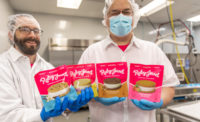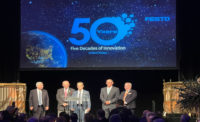With customer satisfaction and the need to avoid costly recalls being perhaps more important than ever, quality assurance (QA) and quality control (QC) testing continue to be crucial in the dairy production process. These tests confirm any products leaving a dairy plant meet the company’s high-quality standards and stringent food safety requirements.
This month, Dairy Foods tackles four important QA and QC topics: new technologies, equipment purchase advice, data management and training best practices. Providing this information are executives from three suppliers: Tyson Rowland, business unit manager for food, New Castle, Del.-based BUCHI Corp.; Sarah Hammond, marketing manager for Sarasota, Fla.-based MoistTech Corp; and Wopke Beukema, senior manager of research and development, applied and food markets, Waltham, Mass.-based PerkinElmer Inc.
In terms of technology, dairy processors are seeking instruments and solutions that provide faster, better results and can look at multiple adulterants or quality components in a single run. Specifically, they want technologies that fit with their resource-stretched and high throughput lab environments. Hence, things like automation and one-button operation are becoming the new normal.
“Dairy customers want lower hands-on time required and less human error in their QA/QC efforts. There is also work being done on QA/QC technologies that are closer to milk collection points and support for plant-based milk products is important in addition to traditional dairy testing,” Beukema says.
PerkinElmer’s LactoScope 300 is its newest product, expanding its FT-IR dairy portfolio and the ability to detect key markers such as fat, protein and lactose levels in milk, cream and whey, Beukema adds.
Looking at the newest technologies specifically, Near Infrared (NIR) comes to mind as something that can assist dairy processors in their QA and QC efforts. The technology is state-of-the-art, fast, and a non-destructive way to measure and control moisture content. NIR is purported to be a proven technology that allows dairy producers to measure moisture without coming into contact with the product — which creates wasted product and lost time — providing instant, accurate and repeatable results. NIR uses a simple light source for measurement, allowing for longer use of equipment, Hammond notes.
“An NIR sensor allows line operators to make immediate process adjustments to avoid downtime, wasted product and time and more. NIR technology provides the most accurate, reliable results in the industry; other technologies require constant re-calibrations, have height interference, experience drifting over time, produce less reflected light energy and overall provide the user with more of an estimated guess rather than true data,” Hammond relays.
With a no-drift design, MoistTech’s NIR technology is a ratio-based measurement system with prime beam, designed to eliminate the sensitivity to distance, while improving stability and accuracy, Hammond adds.
BUCHI also offers NIR technology via The BUCHI FLUX, a console that when combined with ProxiMate NIR, provides the latest in what labs can use to take real-time measurement in one location and instantly share within their corporate network. This allows lab managers to make faster decisions and remove the maintenance of manual data logging, Rowland states.
The right stuff
With many different solutions available, dairy processors need to make sure to make the correct investments. Customers are not just looking for hardware quality anymore, but also the full partnership they can create with an instrument/service provider.
“Uptime is critical and even the highest quality of instrumentation requires maintenance. Not all suppliers have full service in the USA, so ask which ones do and how many are available at any given time to support,” Rowland stresses.
Processors should look for technologies that are agile and can grow with their increasingly busy, resource-challenged and digital labs, Beukema adds.
“Ease of use, automation, easy/connected data management, low training requirements, smaller footprint on the bench/or portability, ease of maintenance, and technologies and reagents that are kinder to the environment are all important,” Beukema states. “Speed of result, price point and accuracy and support for a range of testing options from single samples or runs are also very important, of course.”
Finding the time to purchase and install a moisture control system also can be difficult also. MoistTech offers the following four-step guide to moisture control:
1. You should do your research whenever you’re making a big purchase. This is especially true when it comes to your production output. Buying a device that’s inaccurate or fragile can be detrimental to your business. Make sure you’re prepared by reading reviews, looking at specs and talking to experts.
2. Determine the ideal places within the manufacturing line to assess and monitor moisture control — before and after the oven is very popular in food applications — this will help determine if you need additional hardware to install or if the use of external displays will be needed.
3. Establish the type/model of sensor the company needs. Does it need to be IP67 rated? Will the temperature around the sensor exceed a certain temperature?
4. Establish the actual installation. Will one of the engineers be able to install or would they prefer on-site assistance?
Staff training
QA and QC testing products, like all other equipment, requires staff training. Ongoing training courses is an overlooked service. However, most suppliers offer them, Rowland maintains.
“Just a little bit of training each year for primary users can make the day-to-day operations significantly more efficient,” he suggests. “Take the time to ask what ongoing training has. These can usually be completed in the customer lab or in the suppliers’ lab.”
Each technology varies in terms of training, but NIR is easy to utilize and maintenance free for the most part, experts note.
“It’s based off a simple light absorption concept and once the machine is calibrated to the customer’s specific product, MoistTech units are guaranteed not to drift over time or need a yearly re-calibration in order for it to remain accurate,” Hammond explains.
Once the device is installed and online providing measurements, no senor maintenance is required, Hammond continues.
Based on their own research, dairy processors should determine the best quality assurance/quality control technology for their purposes and then pursue basic knowledge of how those technologies operate. This equipment can provide valuable information to a dairy production facility.
Additionally, routine workflows can usually be managed by lab teams especially if they are heavily used. Solution providers also are making workflows more intuitive through the use of single-button operation and on-screen prompts, reducing the need for rigorous training, Beukema says. It becomes more challenging and demanding when less routine workflows need to be followed and if standard operating procedures (SOPs) are not properly documented.
“The complexity also grows when there are more instruments in the lab that have all different operating systems and workflows,” Beukema explains. “At PerkinElmer, we have combined the instruments for solid and liquid food quality applications into one operating system called Results Plus. In this way, workflows and operating procedures from different instruments can be unified and streamlined which reduces training needs.”
Managing cloud-based data
Once dairy processors have selected the proper equipment for their QA and QC needs, they must manage the data. Although manual capture still certainly exists, as size and volume of operations grow and with that complexity, manually capturing and sharing data can become quickly inefficient, information can be trapped in silos, and the risk for human error increases, Beukema asserts.
Assuming that most dairy processors employ automation, there are a few considerations to factor in if the laboratory information management system (LIMS) is web-based. These include ensuring strong network uptime/availability and creating sufficient data security and protection.
Many processors, however, prefer to have data stored locally so they can always have access to their data.
“The ideal scenario is to have secure, cloud-based data available to anyone approved/appropriate regardless of location to help support timely, data-driven decision making and collaboration,” Beukema suggests. “Regardless, most instruments do have a large storage capacity so whatever the model chosen, the data is still there.”
Cloud-based storage is quickly growing in popularity and here to stay, Rowland adds.
“Instantly adding data from an instrument directly to a cloud storage center for QA/QC to see at any moment is critical for quality and production efficiency,” Rowland says.
Hammond points out that most customers will choose to tie the moisture devices into a PLC so they can make line adjustments in their process.
“This is the idea behind quality in online moisture control, the ability to make adjustments in the line prior to wasted products being made and to also alleviate the time spent on lab testing methods,” Hammond relays.
Display options also are available: to have the moisture content displayed directly above the sensor versus the PLC. Yet, Hammond concludes that the ability to know and control the moisture content within the product is what allows for the following key benefits:
• Improved product quality monitoring.
• Increased plant efficiency (operators can focus on other aspects of the plant).
• Lower energy costs and less waste: Knowing the moisture content before the oven/dryer can help the operational usage of the dryer and reduce the energy used.
• Precise dryer control.
• Sensors have low to no maintenance; minimal man hours spent maintaining.
• Allows for increased process optimization.




